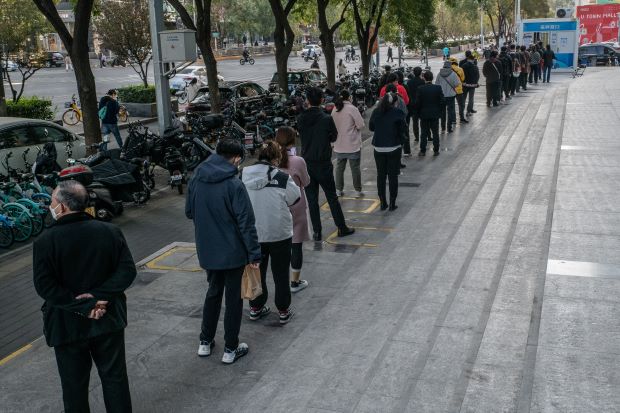China adjusts some pandemic policies, while sticking to ‘Zero-Covid’

By Alexandra Stevenson
BEIJING – As China’s economy continues to be squeezed by the cost of the country’s zero-tolerance approach to COVID-19, the government on Friday (11) softened some of its restrictions, even as it remained committed to its strict pandemic policy.
The shift, while modest, was enough to excite investors who have been searching for any sign that China was ready to ease its rules. The announcement sent Hong Kong’s stock market soaring nearly 8% and buoyed mainland financial markets that have been in a depression over when China will abandon an approach many investors say has hurt the economy.
The move to narrow the scope of China’s vast pandemic apparatus comes a day after its top leader, Xi Jinping, held a meeting with his newly appointed Politburo Standing Committee to discuss COVID-19 amid the economic uncertainty playing out in financial markets, in the boardrooms of the world’s biggest companies and among global leaders.
Responding to the group’s call to “optimize” and adjust a “one-size-fits-all” approach to containing the virus, China’s National Health Commission announced a flurry of changes Friday. The moves appear to reflect a growing recognition at the highest levels that a more targeted approach is needed for controlling COVID-19.
People entering China will now be required to quarantine in a hotel for five days followed by three days of isolation at home. Previously, visitors were required to spend 10 days in quarantine, with seven of those in a hotel or government facility.
Officials also scrapped a penalty system for airlines bringing in travellers with COVID-19 and reduced some of their more burdensome testing requirements, which effectively limited the number of people entering China. Several Chinese travel platforms said searches for international flights had surged Friday compared with the day before.
Domestically, the government limited its contact tracing, part of a broader strategy of mass testing that has led to hundreds of millions of people being thrown into quarantine under heavy guard, provoking anger and discontent. It also got rid of other measures that have left many people stuck at home for weeks just because they live in a neighbourhood where a COVID-19 case has been detected.
Easing COVID-19 policies could have big economic consequences. Shoppers have stayed away from malls as customers stayed home, worried that they might cross paths even momentarily with someone infected and be sent to a long quarantine. Many stores and eateries have closed.
While the moves could lift parts of the Chinese economy, analysts cautioned that the changes are incremental, and the country’s overall pandemic strategy remains onerous. China remains the last major holdout to strict pandemic rules, and it remains unclear how and when Beijing will end its “zero-COVID” policies.
“This is no doubt an important rhetorical shift and may lay the groundwork for a move toward sustained gradual easing, but the market — as it does — is acting like ‘zero-COVID’ is over,” said Taylor Loeb, a China analyst at Trivium, a consulting firm. “That’s just wrong. You don’t unwind a nearly three-year top-level national policy overnight.”
The regulations are still in place, and local officials continue to heed messages from Xi, who has repeatedly praised the tough approach of “putting people and their lives above all else” and argued that the Communist Party has waged an “all-out people’s war to stop the spread of the virus.” Top officials reaffirmed the calls to double down on containing the virus Thursday (10), urging “firm strategic resolve” in controlling the spread of the virus.
China reported more than 10,000 cases Nov. 10, its highest daily count in more than six months, putting to test a COVID-19 strategy that is still largely focused on eliminating the virus.
On Friday, long lines formed at COVID-19 testing centres in Beijing, as municipal officials required many residents to be tested daily — more frequently than in recent weeks. Citing pandemic restrictions, popular attractions in the area were also closed, including Lama Temple and two frequently visited tourist sites along the Great Wall.
“Some interpretations are being too optimistic,” said Bruce Pang, chief economist for Greater China at Jones Lang LaSalle. “The COVID policy will only be fine-tuned in the short term, with the focus shifting between eliminating cases and making more precise measures.”
Foreign executives have complained about being unable to visit local staff and inspect operations for more than two years. Many would-be diners have preferred to stay home. The social costs are climbing, too, as more people are swept up in lengthy lockdowns and tough government quarantines, their frustrations evading China’s internet censors.
Health officials said some of the adjustments to contact tracing were done to reduce the large number of people who have been caught up in the “zero-COVID” dragnet. Previously, even contacts of close contacts were identified and required to isolate.
In the southern manufacturing hub of Guangzhou, where cases have jumped to more 2,500 a day, authorities had resisted a full-blown lockdown, choosing instead to restrict the movement of residents in three of the city’s 11 districts. Following the rule changes, they said at a news conference Friday that they would release all close contacts currently under stay-at-home orders and would stop tracking new ones.
Top officials who met Thursday called for a rectification of “superfluous policy steps”, in a nod to the growing social and economic cost of the country’s increasingly rigid approach to controlling new variants that are milder, albeit more contagious.
But in a sign that China’s leaders are not yet ready to abandon or deviate dramatically from their current strategies, they also stressed that “necessary epidemic control measures must not be relaxed.”
China still has a long way to go before it made any significant changes to its pandemic status quo, longtime China observers like Loeb argued.
“I’ll believe it,” he said, “when I see it.”
-New York Times


Comments are closed, but trackbacks and pingbacks are open.